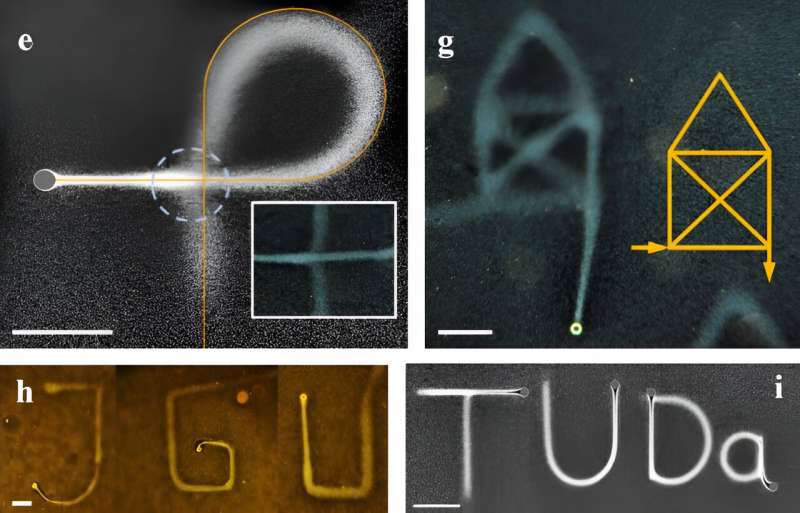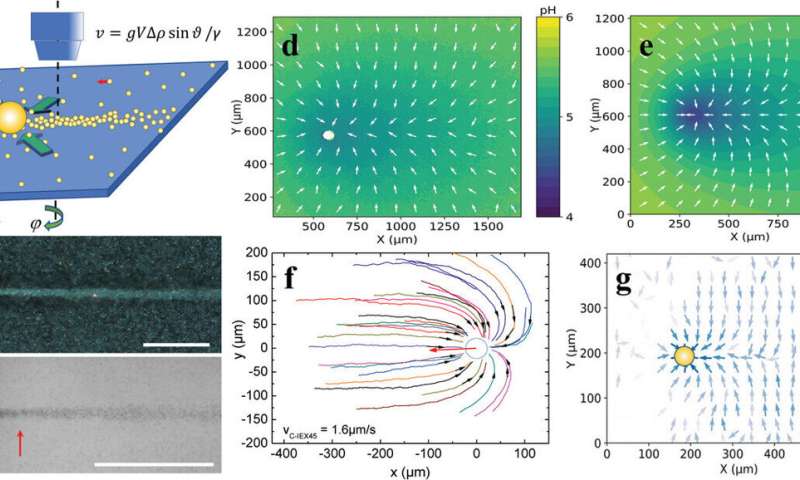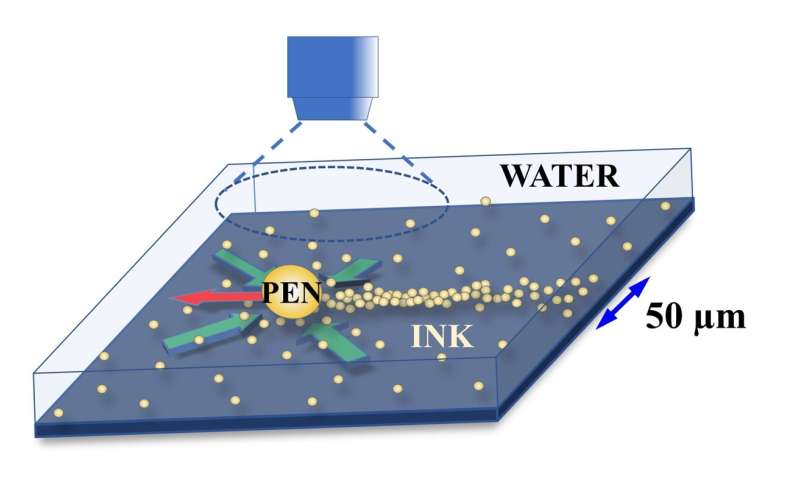This article has been reviewed according to Science X's editorial process and policies. Editors have highlighted the following attributes while ensuring the content's credibility:
fact-checked
peer-reviewed publication
proofread
Writing in water using an ion-exchange bead as a pen

Writing is an age-old cultural technique. Thousands of years ago, humans were already carving signs and symbols into stone slabs. Scripts have become far more sophisticated since then but one aspect remains the same: Whether the writer is using cuneiform or a modern alphabet, a solid substrate, such as clay or paper, is required to fix the written structures in place.
However, researchers at Johannes Gutenberg University Mainz (JGU), TU Darmstadt, and Wuhan University asked themselves how to write in a bulk fluid like water without fixing substrates. The concept would not be unlike the way aircraft leave three-dimensional vapor trails behind them when they cross the sky—compared to two-dimensional writing with a pen on dry paper.
When you dip the nib of a fountain pen in water and try to write something with it in the water, you will, of course, have little success. The movement of the relatively large nib through the water creates turbulence that will eventually eradicate any ink traces left behind. But as the Reynolds number, i.e., the factor used to calculate fluid flow, indicates: The smaller the moving object, the lower the number of vortices it will create.
However, to take advantage of this, a truly minute pen would be needed and this would require a massive reservoir of ink that would cancel out the effect of the tiny pen.
An ion-exchange bead serving as a pen
The team of researchers decided to adopt a completely new strategy to overcome this inherent problem: "We have put the ink directly in the water and use a microbead made of ion-exchange material with a diameter of 20 to 50 microns as a writing instrument," explained Professor Thomas Palberg of JGU. This bead is so small that it generates no vortices at all. The clever bit is that the bead exchanges residual cations in the water for protons, thus altering the local pH value of the water.
If the bead is rolled across the base of a water bath, it traces out an invisible track of lower pH in the liquid. This attracts the ink particles and they accumulate in the path marked out by the ball point. The result is a fine line of just a few hundredth microns in width, marking out the area of the lowest pH value.
To actually write a letter in water, you just need to tilt the water bath in such a way that the bead moves to outline the required character. "During our first attempts, we moved the water bath by hand but we have since constructed a programmable rocker," Palberg continued. "In a water bath no bigger than a one Euro coin, we were able to produce a simple house-like pattern in the size of the tittle of an 'I' character in an 18 point font, and then viewed this under the microscope. But we are still only in the preliminary phase."
Any kind of written form that can be produced using continuous lines can be readily reproduced, as other simulations have shown. Moreover, interruptions, such as breaks between separate letters, could also be achieved because, for example, the ion exchange process could be switched on and off at will using light exposure techniques. Even erasure and correction of what has been written is possible.
-

Writing of straight lines. a) Sketch of the experimental situation. The sample is placed on a stage allowing for tilting by ϑ and rotation around the optical axis (OA) by φ. The IEX (large sphere) rolls under gravity (large red arrow) through settled tracer particles (small spheres), rolling at much smaller speed (short red arrow). Tracers are swept towards the IEX by the co-moving solvent flow field (green arrows) and are assembled in the back of the IEX into a line of positive density contrast, which is left behind and disperses slowly by diffusion. b) Dark field image of C-IEX45 rolling on an inclined glass substrate (ϑ = 3.1°, substrate ζ-potential ζS = −105 mV, vIEX = 7.7 µm s−1) in a suspension of Si832 at c = 0.1 wt.% (tracer ζ-potential ζT = −68 mV). Scale bar: 200 µm. c) The same but in bright field b/w and at c = 0.02 wt.%. The red arrow denotes the location of the line focus. d) Height averaged pH field in lab coordinates as determined by 3-channel micro-photometry for the experiment shown in panel (b). The pH-values are color coded as indicated in the key. Arrows denote the local gradient direction. e) Ground pH-field as derived from panel (d). f) Map of tracer approach trajectories in IEX-relative coordinates for C-IEX45 rolling at vIEX = 1.6 µm s−1. The red arrow denotes the rolling direction of the IEX. g) Tracer velocity field in lab coordinates as determined from Particle Image Velocimetry for the situation in panel (c). Local velocities are color coded according to the key. Credit: Small (2023). DOI: 10.1002/smll.202303741 -

This diagram shows how 'writing in water' works. The 'pen' attracts ink while superfluous ink remains behind to mark the trail it has followed. Credit: Thomas Palberg
A non-specific effect that can be used in various ways
Professor Benno Liebchen and Lukas Hecht of TU Darmstadt have developed a theoretical model that explains the mechanism that makes writing in water viable. The corresponding simulations have demonstrated that this mechanism is a generic, non-specific effect and could thus be employed in a wide variety of forms, according to Liebchen, who is head of the Theory of Soft Matter group at the Institute for Condensed Matter Physics (IPKM) at TU Darmstadt.
"In addition to beads made of ion exchange resins, 'pens' consisting of particles that can be heated by lasers could be employed or even individually steerable microswimmers," he noted. "This could even allow extensive parallel writing of structures in water. Hence, the mechanism could also be used to generate highly complex density patterns in fluids."
An important implication of the theoretical simulations is that this new form of writing is not constrained by the need for a base to the fluid container because the effect is non-specific as to where it occurs in the liquid. It would be sufficient if the ink was rapidly transported to the 'written' outlines and these would only disappear by means of diffusion to make sure the lines remain clearly visible for about ten minutes. Using 'adhesive' UV-sensitive inks, it might even prove possible to fix lines and lettering in place for longer.
There are many potential variations that could be realized by means of using different components in the form of the writing instrument, type of drawn trail, ink, or form of steering employed. One option would be to use fluorescent ink and several very lightweight writing beads that could be moved through the fluid in three dimensions with the help of optical tweezers. This would result not only in luminescent shapes but could also be used for the 3D structuring of fluids.
"Our new approach is very robust and has the potential for extreme modularity," emphasized Palberg. "And it can be developed in an exceptionally wide range of different ways."
The paper is published in the journal Small.
More information: Nadir Möller et al, Writing Into Water, Small (2023). DOI: 10.1002/smll.202303741
Journal information: Small
Provided by Mainz University





















